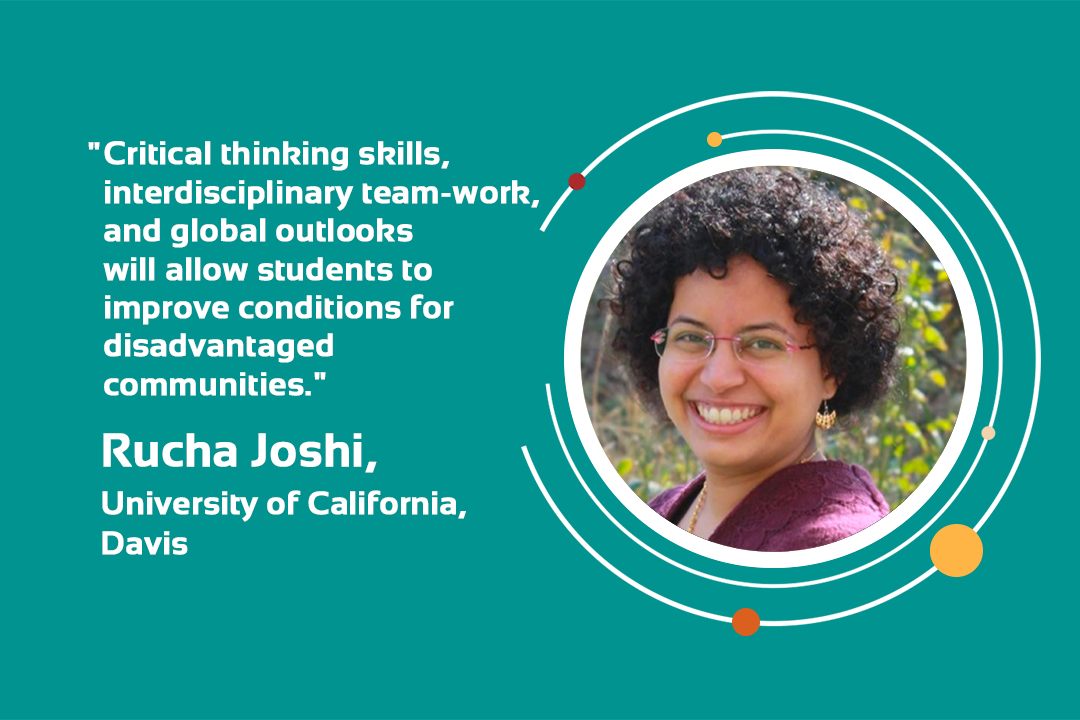
Our Faculty Spotlight series highlights educators within the VentureWell network who are doing transformative work—faculty members who are catalyzing change in higher education and inspiring students to impact the world through invention. This month’s spotlight is Rucha Joshi, Professor of Teaching in the Biomedical Engineering department at University of California, Davis. Dr. Joshi believes that through entrepreneurship, engineering students can launch trailblazing solutions for the most urgent sustainability and climate-related issues of our time. In the Fall of 2020, she received a Faculty Grant to develop two new courses introducing students to the United Nations Sustainability Goals and the importance of creating positive impact through human centered design, interdisciplinary thinking, and entrepreneurial concepts.
how did you become interested in teaching entrepreneurship?
When I was at Purdue University working through my PhD, I took a course called “The Life of Faculty Entrepreneur” taught by Dr. Nathalie Duval-Couetil and Dr. Michael Ladisch, which encouraged my wild ideas about innovations and technology. I ended up being an innovator on a patent with my adviser Dr. Sherry Voytik-Harbin who established a startup at the time, giving me a chance to closely watch a faculty entrepreneur in action. Based on these positive experiences, I applied for the Midwest National Science Foundation (NSF) I-Corps program organized by the Krannert School of Management at Purdue. The material that I learned from Dr. Mathew Lynall there helped me realize that if all students embraced an entrepreneurial mindset, they will be able to turn their innovative ideas into ventures. These personal experiences inspired me to look for ways to incorporate entrepreneurship into the biomedical engineering (BME) curriculum I teach.
what is your favorite thing about teaching?
Seeing a student bloom through the course is my favorite thing about teaching. Seeing someone “get it” and watching the light bulbs go on when I interact with students is a sheer joy. Learning is a two-way process for me. Students learn from me and I learn from them. It is a privilege to be with students capable of accomplishing anything they put their minds to, and bringing to the class diverse backgrounds and enriching conversations.
where would you like to see the field of entrepreneurship in five years?
I hope that interdisciplinary entrepreneurial students will have the opportunity to find solutions to pressing topics such as climate change and its impact on humans and our planet, health, and well-being through sustainable agricultural and environmental systems, urban and environmental design, and green building design. Entrepreneurial projects that require students to apply critical thinking skills, interdisciplinary team-work, and global outlooks will allow them to become change agents in the global community and improve conditions for disadvantaged communities.
what are the challenges you’re tackling in your work today?
One challenge is in bringing everyone in academia (faculty and administrators) on board with the idea of integrating entrepreneurship into the curriculum. It takes time, effort, and vision to convince everyone of the value of an entrepreneurial mindset. Another challenge is getting students to think out of the box and not just work for grades. Many entrepreneurial projects require students to embrace uncertainty—and that can be frustrating for some.
how have you pivoted your courses or teaching style during the pandemic?
The challenge I faced during the pandemic was to provide meaningful dialogue and personalized feedback to students in an online environment. I focused on the process of structuring feedback as personalized, goal-directed, and immediate, and included a peer assessment component to help reduce discrepancies between students’ understandings and assignment goals. The process of providing feedback online helped me identify the common issues students face and gave me opportunities to provide ideal examples of expected work.
what books on entrepreneurship and innovation have you been reading lately, and how have they been insightful to you?
I am currently reading Business Model Generation by Alexander Ostrwaldeer and Yves Pigneur. I first came across this book when I was a graduate student. The helpful visuals, example scenarios, and real-life company business models presented simple yet powerful tools for designing my own desired business model. I like to share it with my students to discuss innovative models of value creation, different angles about starting a business, thinking out of the box, and checking if a model is robust.
For teaching courses, I have found various research articles on infusion of entrepreneurial mindset into curriculum quite useful, along with resources for integrating entrepreneurship into curriculum. For example, the Kern Entrepreneurial Engineering Network (KEEN) offers practical tips on integrating an entrepreneurial mindset into BME curriculum, and provides validated examples from the authors who have implemented the ideas in their class.
what’s your most useful classroom activity or assignment?
Service learning is a useful way to foster experiential learning. My other favorite activities are role play, round robin, think-pair-share, and jigsaw exercises, which are all part of active learning models.
Our Faculty Grants provide up to $30,000 to support the development of programs and classes aimed at helping students hone the skills needed to create novel STEM-based inventions and bring their ideas to market.